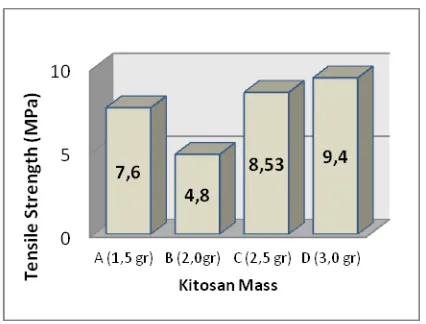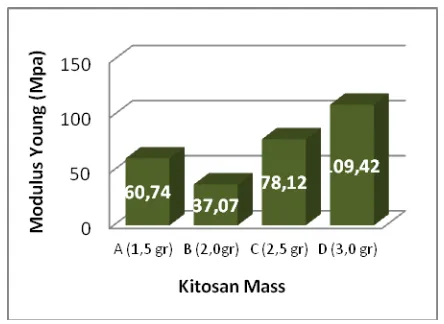Available online at http://journal.walisongo.ac.id/index.php/jnsmr
Synthesis and Characterization of Cassava Shell Based
Biodegradable
Plastic
with Kitosan Addition
Supriyono1, Hamdan Hadi Kusuma1, Mulyatun2 ,and Biaunik Niski Kumila3
1Department of Physics Education, Faculty of Science and Technology, Wallisongo State Islamic University 2Department of Chemistry Education, Faculty of Science and Technology, Wallisongo State Islamic University 3Department of Physics, Faculty of Science and Technology, Wallisongo State Islamic University
Corresponding author: [email protected] Recived: 18 April 2017, Revised : 20 May 2017 Accepted: 20 June 2017.
Abstract
Wasted-plastic which is a hardly-decomposed material was one of the major problems of trash-recycling management in Indonesia. Replacing a common plastic with biodegradable plastic was one of the solution to reduce the amount of undecomposed-materials in the enviroment. Therefore, the aim of this resarch is to study how to synthesis cassava shell based biodegradable plastic and to analyse the effect of kitosan addition on cassava shell based biodegradable plastic properties. There are three basic characterization processes performed to analyse the sample properties, i.e mechanical test, FTIR and biodegradability test. Kitosan enhanced the mechanical and biodegradability properties of samples. The elongation-percentage decreased down to 8,57% along with the increasing the amount of kitosan concentration. FTIR data indicated the presence of O-H, N-H, C-H, C=C, NO2 and C-O organic functional group on biodegradable plastic samples. Kitosan reduce the decomposition process of samples due to its hydrophilicity. Sample with highest concentration of kitosan decomposed at the longest time up to 14 days. . ©2017 JNSMR UIN Walisongo. All rights reserved.
Key words: Palstic; Biodegradable; Citosan;
1.
Introduction
The growth of plastic consumption caused many problems such as increasing the amount
of undecomposed wasted-plastic in
Copyright @2017, JNSMR, ISSN: 2460-4453 such a enviromental-friendly-plastic, so called biodegradable plastic. Biodegradable plastic or
bioplastic is mostly synthesized from
biodegradable materials such as organic substance extract, cellulose, lignin, protein and lipid from animals and plants [3]. Due to its hydrophilicity, low cost and abundance, cassava shell extract was mostly employed as a base materials in biodegradable plastic synthesis [4].
The prominent materials in supporting plastic biodegradable synthesis is kitosan which possess anti-mikrobacterial property [5] and plasticizer which contribute to enhance flexibility and form plastic-like property [6].
Previous research showed that plasticizer addition enhanced the tensile strength and elongation [3] while the kitosan addition enhanced the mechanical property obtaining a
robust and enviromental-friendly
biodegradable plastic [5]. Kitosan contains amine and hydroxyl functional group which enhance the hydrophobicity and chemical reaction with other functional group. Kitosan is a kitin derivative, one of the most abundant polysaccharide in universe [7]. The chemical structure of kitosan is shown by Figure 1.
Figure 1. Chemical structure of Kitosan
This research observed the effect of
varying kitosan concentration to
biodegradable plastic properties.
2.
Experiments Procedure
The research method is generally shown by Figure 2.
Figure 2. Scheme of Research Method
Cassava shell extract was obtained by several steps i.e peeling, immersing in calcium carbonate solution, shieving, filtering and drying. The dry extracted cassava shell is shown in Figure 3.
Figure 3. Dry extracted cassava shell powder
The sample powder was then diluted in 2 % acetic acid solution and DI water. Kitosan mass was varied to 1.5 gr, 2 gr, 2.5 gr and 3 gr. The solution was then stirred for 15 minutes and heated up at temperature of 80C-90C to form a gel solution.
The gel solution was then molded and dried at temperature of 600Cfor 7-8 hours and chilled to room temperature for 6 hours. There
Preparing aterials and tools
Sorbitol
Kitosan solution Cassava shell
are three main sample characterization performed in this research, i.e mechanical property test, Fourier Transform Infra-Red (FTIR) characterization and biodegradability test. Mechanical characterization was executed in Materials Engineering Laboratory, Faculty of
Engineering, Gajah Mada University,
Yogyakarta. FTIR characterization was executed in Organic Chemistry Laboratory, Faculty of Science and Mathematics, Gajah Mada University with the range of wavelength of 500-4000 cm-1. This test is to observe the functional group contained in the sample. The biodegradability test was performed in Chemistry Laboratory, Faculty of Science and Technology, UIN Walisongo with soil burial technique. The sample was burried in a soil and exposed to air. The biodegradability property is obtained from the percentage of loss mass after exposure to the air.
3.
Result and Discussion
The effect of kitosan addition to the mechanical property is shown by Figure 7.
Figure 4. The influence of Kitosan to the Tensile Strength
Figure 4 shows that sample B has the lowest tensile strength, i.e 4,8 Mpa and sample D has the highest tensile strength, i.e 9,4 Mpa. The kitosan addition enhance the tensile strength due to increasing the amount of hydrogen bond consisting in the sample which require higher amount of energy to break the bond [8]. Furthermore, the tensile strength of
sample B is lower than sample A. This is due to non-optimal heating process on sample B.
Materials with high tensile strength is
mostly possessing a low elongation
percentage. This is due the nature of a high tensile strength materials is hard to be strecthed. The elongation percentage is deminished along with the increasing kitosan
concentration due to decreasing its
intermolecular distance [9]. The effect of
kitosan concentration on elongation
percentage is shown by Figure 5.
Figure 5. The effect of kitosan concentration on elongation percetage
Figure 5 shows that the elongation percentage is decreased along with the increasing kitosan concentration, except for sample B. The biodegradibility quality of samples was then compared to conventional plastic.
Tabel 1. The quality comparison of conventional plastic and biodegradable plastic
Con-vetional plastic
Biodegradable plastic
A B C D
Tensile strength
(MPa)
24.7-302 7,6 4,8 8.53 9.4 %
elongation 21-220 12,51 12.86 11.47 8.57
Copyright @2017, JNSMR, ISSN: 2460-4453 Figure 6 shows that the Modulus Young is
increasing along with the increasing kitosan mass contained in the samples, except for sample B. That is due to the incomplete heating process of sample B.
Figure 6. The Effect of Kitosan Mass Variation to Modulus Young of Biodegradable Plastic
In conclusion, the value of tensile strength is in agreement with that of modulus young. Those values are increasing along with the increasing kitosan mass on the sample. FTIR test is only applied on the sample possesing the highest tensile strength, i.e. sample D. FTIR data shows that the peak at 3433.29 cm-1 is assigned to O-H functional group, 3873.06 cm-1 is assigned to N-H secondary amine, 2924.09 cm-1 is assigned to C-H alkana with low intensity, the high peak intensity at wave number of 1635.64 cm-1 is assigned to C=C, 1381,03 cm-1 is assigned to NO2 and 1026.13 cm-1 is assigned to C-O functional group. Those functional groups is organic functional groups
leading to the enviromental-friendly
biodrgradable plastic [9].
Figure 7 shows that sample A was decomposed on the day-10, sample B was completely decomposed on the day-8, sample C was completely decomposed on the day-12 and sample D was completely decomposed on the-day 14. Sample D with the highest amount of kitosan addition decomposed in the longest time. Kitosan is hydrophobic and being able to enhance the tensile strength of samples. Therefore, sample with the highest amount of
kitosan addition require a longer time to be decomposed[10].
Figure 7. The plastic mass during biodegradability test for 14 days
4.
Conclusion
The cassava shell based biodegradable plastic was successfully synthesized with kitosan addition. The kitosan addition enhance the mechanical property of samples. That is due to the high amount of hydrogen bond which require more energy to break the bond. The number of elongation percentage is in inverse to the number of the tensile strength.
Kitosan is hydrophobic. Therefore, the
biodegradable plastic is decomposed at longer time for the sample with the higher amount of kitosan concentration.
Acknowledgment
The authors wish to thank Department of Physics, Wallisongo State Islamic University for supporting this work
References
[1] D. Arinandha, Wajah )ndustri Plastik
)ndonesia. [Online]. Available:
http://www.kompasiana.com/dhitaarina nda/wajah-industri-plastik-indonesia 54f7c9b9a33311df1d8b4a18. [Accessed: 05-Nov-2015].
[2] M. Ramadhani, L)P) Garap Sampah
Plastik. [Online]. Available:
[3] Y. Darni and U. Fathonah, Pembuatan Plastik Biodegradable Dari Campuran Pati Ubi Jalar (Ipomoea Batatas) Dan Selulosa
Residu Rumput Laut (Eucheuma
Spinossum) Dengan Gliserol Sebagai
Plasticizer, in Seminar Nasional Hasil
Riset dan Srandarisasi Industri: Hasil Riset Dan Standarisasi Industri Berbasis Agro Serta Implementasinya, 2011.
[4] D. P. Ajeng, Pembuatan dan Karakterisasi
Struktur Mikro dan Sifat Termal Film Plastik Berbahan Dasar Pati Biji Nangka
Artocarpus heterophyllus , Universitas
Negeri Semarang, 2013.
[5] Y. D. (artatik and dkk, Pengaruh
Penambahan Kitosan Terhadap Sifat
Mekanik Dan Biodegradable Bioplastik,
Universitas Brawijaya, 2013.
[6] H. Mulyono, Kamus Kimia. Jakarta: Bumi Aksara, 2005.
[7] W. Setiani, Preparasi dan Karakterisasi
Edible Film dari Poliblend Pati
Sukun-Kitosan, Valensi, vol. 3, no. 2, p. 101, 2013.
[8] P. Coniwanti and dkk, Pembuatan Film
Plastik Biodegredabel Dari Pati Jagung
Dengan Penambahan Kitosan dan
Pemplastis Gliserol, J. Tek. Kim., vol. 20, no. 4, 2014.
[9] ). )ndriyanto and dkk, Karakteristik
Plastic Biodegradable Pektin Lidah
Buaya, Semarang, 4.
[10] B. ). (idayah and Dkk, Pembuatan Biodegradable Film Dari Pati Biji Nangka
(Artocarpus Hetrophyllus) Dengan
Penambahan Kitosan, in Pembuatan
Biodegradable Film Dari Pati Biji Nangka
(Artocarpus Hetrophyllus) Dengan


